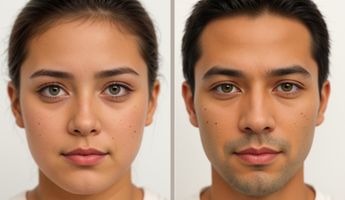Sex Reassignment Surgery (Female To Male) in Vietnam
Search and Compare the Best Clinics and Doctors at the Lowest Prices for Sex Reassignment Surgery (Female To Male) in Vietnam

Find the best clinics for Sex Reassignment Surgery (Female To Male) in Vietnam
No pricing info available
Thailand offers the best prices Worldwide
Price: $ 556
From 15 verified reviews
Trung Hoang, 21 September 2019
The eyelid nose in GNG is very full, the height is high enough so it looks very natural
- Home
- Vietnam
Compare Before & After Photos of _procedure_photos.phpSex Reassignment Surgery (Female To Male)


Half-side view


Front view


Half-side view


Front view


Front view


Front view


Front view


Front view
WHY US?
At Medijump, we're making medical easy. You can search, compare, discuss, and book your medical all in one place. We open the door to the best medical providers worldwide, saving you time and energy along the way, and it's all for FREE, no hidden fees, and no price markups guaranteed. So what are you waiting for?

Free

Best Price

Widest Selection

Risk-Free
What you need to know about Sex Reassignment Surgery (Female To Male) in Vietnam

Some people are born male and some are born female. While there are some people who are transgender, whose gender identity does not match their assigned sex. Sex change surgery, also known as gender reassignment surgery (GRS) or sex reassignment surgery (SRS) is there to help these people. This is a surgical procedure that changes the sex of a person. It changes a transgender person’s physical appearance according to there identified gender. It treats gender dysphoria in these people. This includes both feminization and masculinization surgeries. In masculinization surgery, there are two domains:
- Top surgery
- Bottom surgery.
In top surgery, mastectomy is performed to remove the breasts and give your chest a more male-like contour. Bottom surgery involves increasing the length of the clitoris which is called metoidioplasty, production of a penis, and scrotum which are known as phalloplasty and scrotoplasty respectively, and removal of the uterus that is a hysterectomy. This surgery is not for everyone. A number of things are considered before opting for surgery. However, normal people with assigned gender can also go for this if they want to.
Before the operation, your assigned sex does not correspond to your gender identity. You suffer from gender dysphoria. You feel uncomfortable in your skin. However; after the surgery, you are a person of your desired sex. You are converted from a female to a male.
What is the cost of Sex Reassignment Surgery (Female To Male) in Vietnam?
Like any intricate healthcare process, the price for undergoing Sex Reassignment Surgery (Female To Male) is not a fixed figure in Vietnam. The final tally significantly sways due to issues like the patient's comprehensive health status, distinct surgical necessities, and the operating surgeon's level of proficiency. It's vital, too, to factor in the cost of post-procedure care, prescribed medicines, and extra treatments, all of which substantially contribute to the total expenditure.
Moreover, distinct clinics situated in Vietnam might provide an array of payment structures or offer financial aid alternatives. It's advisable to undertake thorough investigations or reach out to prospective clinics directly to obtain a precise cost prediction.
What does a Sex Reassignment Surgery (Female To Male) Procedure Involve?
Anesthesia is given to ensure that the patient does not suffer from pain during the surgery. Top and bottom surgeries are performed differently.
-
Mastectomy: It is performed in two ways. In one method, an incision is given around the areola and excessive fat and breast tissue are removed through it. The skin is left as it is for a year. It retracts in this period of time. This method leaves prominent scars. In the other method, excess skin is also removed along with the tissue and fat. This leaves fewer scars. After this, male-like the contour of the chest is obtained.
In the other step, female reproductive organs that are present inside your body are removed.
-
Hysterectomy: Total Hysterectomy is the removal of uterus and cervix. Another surgery, bilateral salpingo-oophorectomy (BSO) is performed to remove fallopian tubes. In this way, the entire female reproductive system is eliminated from the body.
After this, procedures for the construction of male reproductive organs begin. They include,
- Metoidioplasty: Androgenic hormones are given to increase the length of the clitoris. Length is increased to almost 1.6 to 2 inches.
- Phalloplasty: It is performed to create a penis or to increase the length of it. It can be done in 4 ways. All of these work on the same principle. A flap of skin is taken from a donor site of the body such as an arm or abdomen to make a penis out if it. It is joined to the urethra. This is the most complicated step of GRS. An erectile prosthesis is inserted into the penis to achieve an erection.
- Scrotoplasty: Scrotum is produced from labia majora and prosthetic testes are inserted into it.
How Long Should I Stay in Vietnam for a Sex Reassignment Surgery (Female To Male) Procedure?
It is a long procedure involving a number of surgeries. There is top surgery and bottom surgery. Mastectomy takes 2 to 3 hours in the operation theatre. While bottom surgery requires more time. It takes 8 to 10 hours for a female to male GRS. You should plan to stay in the area for at least 14 days after your Procedure, During this duration, your health conditions are monitored regularly and your stitches are removed after 10 to 14 days. You can go home when allowed to by your physician.
What's the Recovery Time for Sex Reassignment Surgery (Female To Male) Procedures in Vietnam?
You will have to take 2 weeks off work. After 2 weeks, you can start a light activity and can go back to office work. A Patient will need more time to get back to physical work. You can start strenuous activity 4 to 6 weeks after bottom surgery. Pain killers are given in this period to deal with moderate pain. Scars take some time to fade away. It can take years after the surgery to settle both physically and psychologically.
What sort of Aftercare is Required for Sex Reassignment Surgery (Female To Male) Procedures in Vietnam?
Following points should be considered to look after you post-surgery:
- Go for regular check-ups.
- Take your medicines as and when prescribed by the doctor.
- Live with someone who takes care of you while you recover.
- Abstain from sexual activity till allowed by your doctor.
- Do not take a bath or shower with bandages intact. It can cause infection.
- Avoid strenuous exercise in the early few days after surgery.
- Do not lift heavy objects; it puts pressure on your stitches.
- Avoid excessive movement. Take a rest.
What's the Success Rate of Sex Reassignment Surgery (Female To Male) Procedures in Vietnam?
The success rate of Sex Reassignment Surgery (Female To Male) within Vietnam depends on a spectrum of elements. Such factors encompass the proficiency and prior expertise of the surgical unit, the comprehensive health condition of the person, their mental readiness, and compliance with the suggested after-treatment attention. An abundance of research has pointed out that a majority of individuals who choose Sex Reassignment Surgery (Female To Male) acknowledge a marked enhancement in their lifestyle quality, elevated mental health, and a noteworthy contentment level with the physical transformations.
According to a study, 97% of the people who went through this surgery found their results satisfactory. You need to be sure before opting for it, as it is a lifetime decision. GRS is mainly for the treatment of dysphoric and transgender people.
Are there Alternatives to Sex Reassignment Surgery (Female To Male) Procedures in Vietnam?
The following are some alternatives to sex reassignment surgery:
- Hormone replacement therapy: this therapy aids in changing your secondary sex characteristics according to your desired sex. In the case of female to male sex change, testosterone is given. This induces hair growth and coarseness of voice. It reduces breast growth and changes in fat distribution in your body. It also stops menstruation.
- Altering physical appearance: you can alter your physical appearance, your dressing, your hair, your makeup in accordance with your desired sex. Do regular exercises to build up muscle mass which will make you look like a male.
- Psychological counseling: it will make you handle your personality. Gender reassignment surgery cannot be reversed. Therefore, you should make your decision wisely.
- Cosmetic surgery: it is a wide field covering a number of domains. It can alter your facial features, your body fat, your waist, your stomach, your chest to transform you into your desired gender. You can go for liposuction, mastectomy, Botox, fillers, Rhinoplasty, etc.
All of the methods, mentioned above are not permanent but are helpful. For permanent change, you have to go for sex reassignment surgery.
What Should You Expect Before and After the Procedure
Prior to initiating the Sex Reassignment Surgery (Female To Male), it is necessary to ensure each individual undergoes thorough psychological analysis and counseling. These checks serve to affirm the patient's emotional readiness and ability to cope with the aftermath of the procedure. In addition to mental health evaluations, multiple medical assessments are implemented to inspect their overall health state. Recognizing any pre-existing health issues is of utmost importance as they can potentially impact the result of the surgery. Regularly scheduled consultations with knowledgeable healthcare professionals are fundamental to this process. These meetings will entail in-depth explanations and discussions to help formulate a holistic understanding of the entire procedure and its ensuing effects.
After the execution of the surgical procedure, there's a need for mental readiness for an extensive recovery period. This stage typically demands diligent post-procedure care and major lifestyle adjustments. Surgical recovery isn't typically a swift process - it's a path that entails physical changes and lifestyle adaptations, necessitating a period of adjustment for the patient. The adoption of healthy habits becomes particularly important during this period. Activities like regular physical activity, adhering to a nutritious diet, and incorporating stress-relief practices are proven to carry several benefits. Moreover, in addition to the emphasis on physical recuperation, mental health should also be prioritized equally.
What are Potential Risks of Sex Reassignment Surgery (Female To Male)?
Each surgical procedure comes with inherent risks and potential complications, including Sex Reassignment Surgery (Female To Male). These might encompass general surgical risks such as infection, bleeding, or adverse reactions to anesthetic drugs. Specific to Sex Reassignment Surgery (Female To Male), there may also be healing-related risks, which could result in necrosis or lackluster cosmetic outcomes. Educating oneself about the possible complications of surgical procedures is beneficial for better preparation.
Additionally, extended exposure to hormonal treatment might escalate the risk of cardiovascular ailments or osteoporosis. There could also be mental health concerns such as depression or anxiety, which may spring from society's responses or personal adaptation to a new identity. Frequent consultations with a healthcare professional are essential to keep track of and mitigate any possible risks or complications.
Whilst the information presented here has been accurately sourced and verified by a medical professional for its accuracy, it is still advised to consult with your doctor before pursuing a medical treatment at one of the listed medical providers
No Time?
Tell us what you're looking for and we'll reachout to the top clinics all at once
Enquire Now

Popular Procedures in Vietnam
Prices Start From $497

Prices Start From $1,552

Prices Start From $500

Prices Start From $1,000

Recommended Medical Centers in Vietnam for Sex Reassignment Surgery (Female To Male)

- Interpreter services
- Translation service
- Religious facilities
- Medical records transfer
- Medical travel insurance
- Health insurance coordination
- TV in the room
- Safe in the room
- Phone in the room
- Private rooms for patients available

- Interpreter services
- Translation service
- Religious facilities
- Medical records transfer
- Medical travel insurance
- Health insurance coordination
- TV in the room
- Safe in the room
- Phone in the room
- Private rooms for patients available

- Interpreter services
- Translation service
- Religious facilities
- Medical records transfer
- Medical travel insurance
- Health insurance coordination
- TV in the room
- Safe in the room
- Phone in the room
- Private rooms for patients available

- Interpreter services
- Translation service
- Religious facilities
- Medical records transfer
- Medical travel insurance
- Health insurance coordination
- TV in the room
- Safe in the room
- Phone in the room
- Private rooms for patients available

- Interpreter services
- Translation service
- Religious facilities
- Medical records transfer
- Medical travel insurance
- Health insurance coordination
- TV in the room
- Safe in the room
- Phone in the room
- Private rooms for patients available

- Interpreter services
- Translation service
- Religious facilities
- Medical records transfer
- Medical travel insurance
- Health insurance coordination
- TV in the room
- Safe in the room
- Phone in the room
- Private rooms for patients available

- Interpreter services
- Translation service
- Religious facilities
- Medical records transfer
- Medical travel insurance
- Health insurance coordination
- TV in the room
- Safe in the room
- Phone in the room
- Private rooms for patients available

- Interpreter services
- Translation service
- Religious facilities
- Medical records transfer
- Medical travel insurance
- Health insurance coordination
- TV in the room
- Safe in the room
- Phone in the room
- Private rooms for patients available

- Interpreter services
- Translation service
- Religious facilities
- Medical records transfer
- Medical travel insurance
- Health insurance coordination
- TV in the room
- Safe in the room
- Phone in the room
- Private rooms for patients available

- Interpreter services
- Translation service
- Religious facilities
- Medical records transfer
- Medical travel insurance
- Health insurance coordination
- TV in the room
- Safe in the room
- Phone in the room
- Private rooms for patients available
Sex Reassignment Surgery (Female To Male) in and around Vietnam
About Vietnam
Situated at the extreme east of the Indochina Peninsula, Vietnam is a country that exhibits profound cultural richness and captivating landscapes. It holds the distinction of being the world's 15th most populous country, housing over 94 million residents scattered across its diverse geographical expanse. Despite grappling with issues like poverty and corruption, Vietnam's impressive economic performance cannot be overlooked. Notably, the country boasts a commendable GDP growth rate and is celebrated as one of the fastest-growing economies globally.
This country is well-known around the globe for its breathtaking natural beauty. It's also recognized for its energetic, larger-than-life cities that are always buzzing with activity. Furthermore, its culture is intricate and assorted, attracting millions who appreciate rich customs and traditions. In 2018, this place was a magnet for tourists, drawing in over 15 million visitors who were eager to immerse themselves in its unique way of life.
Broadly celebrated for its splendid scenic landscapes, there's an undeniable charm this country possesses. The vivacious megacities are a thrilling fusion of noise, colors, and life that leaves an impression on all who stroll through them. The cultural mosaic of this land is complex, and varied, presenting evidence of a fascinating history shared through countless generations. The year 2018 saw floods of tourists - well in excess of 15 million - come to explore, each leaving with their own tale of discovery within its borders.
The rapid development of Vietnam has made it into the next medical tourism hub in Southeast Asia. Now, medical tourists consider the country as their potential medical destination. Many new medical centers have sprung up and welcomed thousands of patients to relax and enjoy their treatment. The country offers a wide range of cost-effective medical treatment, well-trained doctors, and professional equipment. The country focuses on promoting medical tourism to neighboring markets such as Laos and Cambodia.
Popular Parts of Vietnam
- Ho Chi Minh, formerly Saigon, is the most populous city in Vietnam. It is the financial center and home to the largest stock exchange in the country. Tourists coming to the city can enjoy its many tourist spots such as shopping in the Ben Thanh Market, viewing the city from Saigon Skydeck, discovering the city’s history from The War Remnants Museum, or learning the culture of Jade Emperor Pagoda. Other than the attractions, the city is also famous for its traditional food, including pho and pork rolls.
- Hanoi is the capital of Vietnam and the country’s major metropolitan and political center. Tourists will find many well-preserved colonial buildings, museums, and pagodas. As one of the most ancient capitals in the world, most tourists will be delighted to explore the city’s historic Old Quarter, spend a beautiful day in Hoan Kiem Lake, or visit the Temple of Literature.
- Hoi An invites tourists to experience a slow-paced, relaxing lifestyle. The city’s Old Town has successfully preserved Japanese merchant houses and Chinese temples. To get a glimpse of the city, many tourists will opt for a bicycle tour. The city also offers a unique farming and fishing experience for its visitors. Off the coast of the city, tourists will be overjoyed to find a diving paradise with hundreds of different coral and fish.
- Nha Trang is a coastal city on the South Central Coast of the country. Tourists usually come to this city for its stunning white sandy beaches and scuba diving. In addition to the beautiful beaches, Nha Trang Bay is considered to be one of the world’s most beautiful bays. The city is also home to the remnants of the Champa Kingdom, gothic-style Catholic churches, and many Buddhist temples.
- Da Nang is located on the coast of the South China Sea, making it the most important port city of Vietnam. The city continues to evolve each year, with modern hotels and restaurants being developed all around it. It is the tourist capital of South Central Vietnam. Tourists visit the city to enjoy its tranquil beaches with crystal clear waters, beautiful ancient pagodas, interesting French colonial buildings, and green national parks.
Weather and Climate in Vietnam
Vietnam, situated uniquely on the map, experiences differing climates in its varied regions. If you travel south, you'll find a tropical monsoon climate. This climate type typically comes with two main seasons - the wet season and the dry season.
Straying north, however, you'll encounter a different story altogether. Here, the climate is categorized as monsoonal but it's accompanied by four clear-cut seasons - spring, summer, autumn, and winter. So, regardless of the time of year, there's a high chance you'll experience a unique slice of Vietnamese weather, depending entirely on which part of the country you've set foot in.
- The south experiences wet and dry season and the wet season lasts from September to December. There is more rainfall between September and November. The dry season starts in January and ends in August and the average annual temperature is around 26 °C. Some cities such as Da Nang are prone to typhoons during the wet season.
- In the north, spring starts in February characterized by some rain and cold temperature. The end of April is the start of summer, with intense sunshine and sometimes even a heatwave. The average temperature during Summer is 27.5 °C but it can feel a lot hotter. Autumn starts in September and ends in November. Autumn has the best weather, with a lot of sunshine and calm wind. From December to January is Winter and it is generally cold with an average temperature of 17 °C which can drop as low as 7 °C.
Getting Around in Vietnam
There are numerous airports in Vietnam that connect the major cities. However, there are three major international airports where international visitors usually arrive at, Ho Chi Minh, Hanoi, and Da Nang. Most international flights will arrive at Tan Son Nhat International Airport which serves domestic and international flights to and from major cities in Asia, Europe, and Australia. In terms of capacity, the biggest airport in the country is the Noi Bai International Airport in Hanoi.
The airport is a hub for both local and global travel. It houses two terminals within its boundaries. Terminal 1 is tasked with the management of domestic flights, servicing those traveling within the country's borders. On the other hand, Terminal 2 oversees international flight operations, connecting this airport to numerous cities across Asia and Europe. Affordable airlines, including the likes of Jetstar Pacific and VietJet Air, schedule flights departing from and arriving at both Tan Son Nhat and Noi Bai airports - a testament to the airport's reach and convenience to travelers with varying budget needs.
Tourists do have a few travel options to get around Vietnam. The country is served by trains running from Ho Chi Minh City to Hanoi and it stops in many of the popular areas such as Da Nang and Nha Trang. Buses are a great option for tourists to get around the country and the buses are privately operated buses called “open tour” buses. There is also a national bus system, but they are generally not as comfortable as the private buses.
Taxis are available in most cities and can be hailed directly from the streets or via a phone call. The fare usually starts at VND 10,000 to VND 12,000. If you need to be quick, try the motorcycle taxis known as Xe Om. You will need to negotiate the price but they can be found in most parts of the cities. Cyclo (similar to trishaw) is also available for short-distance travel within a city. For easier travel, opt for Grab Motorbike, an online hailing app similar to Uber.
Tourist Visas in Vietnam
- Citizens of 24 countries, including Singapore, Thailand, Russia, and Japan, can enter and stay in Vietnam for up to 90 days without a visa.
- Citizens of 81 countries, including the United States, the European Union, and Canada, can apply for an e-visa. An e-visa is a single-entry visa that allows the holder to stay in Vietnam for up to 30 days.
- Citizens of all other countries need to apply for a visa at a Vietnamese embassy or consulate.
How to apply for an e-visa:
- To apply for an e-visa, you will need to create an account on the Vietnam e-Visa website and complete an online application form. You will also need to upload a digital photo of yourself and a scan of your passport.
- The e-visa fee is USD 25.
- Once your application is approved, you will receive an e-visa by email. The e-visa must be printed out and presented to immigration officials upon arrival in Vietnam.
Additional information:
- All visitors to Vietnam must have a passport valid for at least six months beyond their intended date of departure from Vietnam.
- Visitors who obtain an e-visa must have a valid passport and a digital photo.
- Visitors who apply for a visa at a Vietnamese embassy or consulate may also need to provide additional documentation, such as a proof of onward travel or a letter of invitation.
Additional Information
- Local Currency: The official currency is the Vietnamese Dong and 1 USD converts to VND 24,455.
- Money & Payments: ATMs are widely available throughout the country. Credit and debit cards are accepted in many hotels but most restaurants and shops still only accept cash. Tipping is generally not expected but will be appreciated.
- Local Language: Vietnamese is the local language. English is not widely spoken, but if you are staying in popular tourist areas, there will be people who can speak some English.
- Local Culture and Religion: Most of the population follows the Vietnamese folk religion. Buddhism, Christianity, Hoahaoism, Islam, and Hinduism are also freely practiced.
- Public Holidays: The country celebrates major religious and national holidays such as New Year’s Day, Saigon Liberation Day, and Vietnam Traditional Lunar New Year.
Popular Searches
- Plastic Surgery in Thailand
- Dental Implants in Thailand
- Hair Transplant in Thailand
- Breast Augmentation Thailand
- Gastric Sleeve in Thailand
- Gender Reassignment Surgery in Thailand
- Laser Hair Removal in Bangkok
- Botox in Bangkok
- Dermatology in Bangkok
- Breast Augmentation in Bangkok
- Coolsculpting in Bangkok
- Veneers in Turkey
- Hair Transplant in Turkey
- Rhinoplasty in Turkey
- Stem Cell Therapy in Mexico
- Rhinoplasty in Mexico
- Liposuction in Mexico
- Coolsculpting in Tijuana
- Rhinoplasty in Korea
- Scar Removal in Korea
- Gastric Sleeve in Turkey
- Bone Marrow Transplant in India
- Invisalign in Malaysia
- Plastic Surgery in the Dominican Republic
- Tummy Tuck in the Dominican Republic
- Plastic and Cosmetic Surgery in Poland
- Rhinoplasty in Poland
- Hair Implant in Poland
- Dental Implants in Poland
- IVF in Turkey
